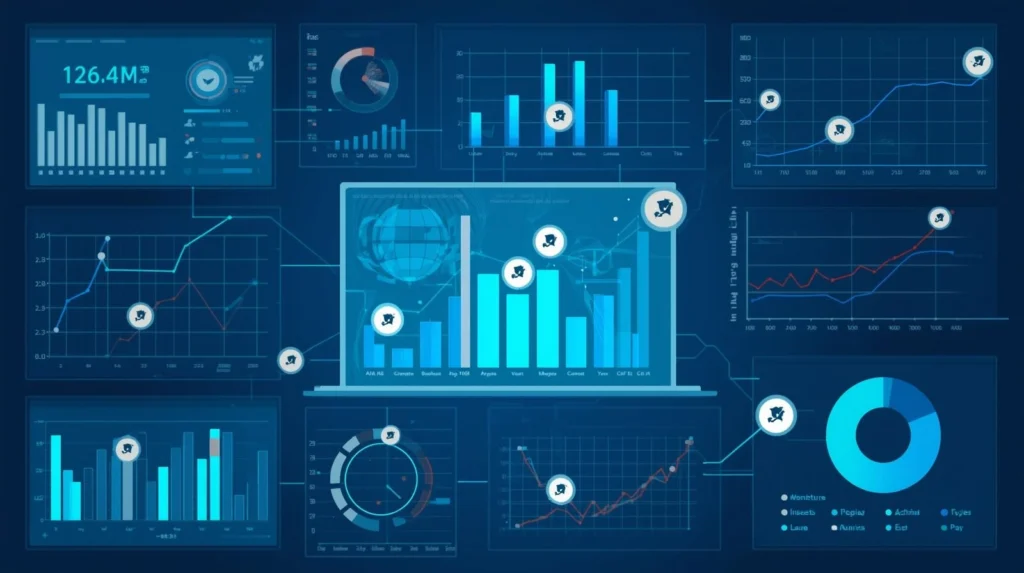Introduction
In today’s hyper-competitive business landscape, customer interactions (over calls, chat, voice, and more) are a critical touchpoint. Even outside traditional call centers, many businesses rely on phone conversations — whether for support, sales, consultations, or follow-ups. That’s where call monitoring and quality assurance programs matter.

When done right, these programs do more than just catch errors. They elevate your customer experience, align your team with best practices, reduce churn, and directly impact your bottom line. In this article, you’ll learn exactly how to implement an effective call monitoring program for quality assurance — step by step — so your business can scale service excellence.
Implementing an effective call monitoring program ensures your team delivers consistent, high-quality interactions while providing insights to improve processes, training, and KPIs.
Explore more insights and implement a robust QA program with VoiceTotal: https://voicetotal.com/blog/
What are Call Monitoring and Quality Assurance?
First, let’s clarify terms.
Call Monitoring refers to the process of observing (live or recorded) telephone interactions between agents (or staff) and customers. You evaluate tone, accuracy, compliance, resolution, empathy, and more.
Quality Assurance (QA) is the structured framework that defines how those interactions should be assessed — via scorecards, KPIs, guidelines, and feedback loops.
Together, call monitoring + quality assurance become a system to ensure every conversation aligns with your brand promise, supports customers, and maintains consistency.
Although many references focus on contact centers, the same principles apply to any business that uses calls: support lines, sales teams, medical practices, professional services, local businesses, and more.

Call monitoring is the process of listening to or analyzing customer interactions in real-time or post-call to assess performance. Quality assurance (QA) ensures that every call meets predefined standards for service, compliance, and customer satisfaction.
Key components:
-
Listening to live or recorded calls.
-
Scoring calls using quality metrics.
-
Providing actionable feedback for agent improvement.
-
Aligning operations with KPIs and business goals.
Benefits:
-
Improved customer satisfaction and retention.
-
Reduced operational errors.
-
Enhanced agent performance and morale.
-
Better adherence to compliance and legal standards.
The Importance of Quality Assurance Monitoring
QA monitoring is crucial for SMBs, enterprises, and BPOs. It allows managers to:
-
Track agent performance accurately.
-
Identify recurring issues in service delivery.
-
Pinpoint training needs for specific agents or teams.
-
Measure the impact of process changes on customer experience.
Example:
A SaaS company implemented call monitoring and saw customer churn decrease by 15% after retraining agents using insights from monitored calls.
Stats:
-
According to HubSpot, organizations with a structured QA program report higher first-call resolution and CSAT scores.
-
Call monitoring can boost conversion rates by 20–30% in sales-focused call centers.
Why It’s Crucial — Benefits & ROI
Implementing a proper call monitoring & QA program delivers significant benefits:
-
Better Customer Experience
You spot pain points (e.g. “agent hung up too quickly” or “customer tone escalated”) and correct them proactively. -
Improved Agent Performance
With consistent feedback, agents can improve their communication, script adherence, upsell skills, and handling of objections. -
Compliance & Risk Mitigation
For industries with legal or regulatory constraints (finance, health, etc.), monitoring ensures adherence to scripts, disclaimers, or privacy protocols. -
Increased Conversion & Retention
Having better conversations leads to more closed deals, fewer callbacks, and higher satisfaction. (Better service often means more repeat business, referrals, and reduced churn.) -
Data-Driven Decisions
Metrics from QA help you identify training gaps, script flaws, operational bottlenecks, and process improvements. -
Scalable Quality
As your volume grows, you can’t personally oversee every call. A program with tools, AI, and standards helps maintain quality at scale.
Evidence & Industry Insights
-
Monitoring platforms and quality management software now include features like speech analytics, sentiment scoring, and dashboards to evaluate every call.
-
Best practices advice suggests that modern QA programs should evolve to real-time and AI-assisted models rather than just manual evaluations.
-
In contact center contexts, companies that shift toward transparent, agent-inclusive QA see improved morale and stronger performance.
These findings apply equally to non-call-center organizations: your team benefits if they see evaluation as growth, not punishment.
Key Components & Metrics of a Robust Monitoring Program
What to Measure / Metrics

| Metric | Description | Target / Goal |
|---|---|---|
| QA Score / Quality Score | Internal evaluation via scorecard | Improve over time |
| CSAT (Customer Satisfaction) | Post-call survey score | 85%+ or business-suitable benchmark |
| First Call Resolution (FCR) | Issue resolved in one call | Higher is better |
| Average Handle Time (AHT) | Duration per call | Balanced: not too short, not too long |
| Sentiment / Tone Score | Emotional tone of customer/agent | Higher positivity |
| Compliance Rate | % of calls adhering to protocol | 100% in regulated contexts |
| Agent Improvement Rate | % change over time in QA scores | Upward trend |
Essential Components / Framework
-
Scorecards & Evaluation Rubric
Define categories (e.g. greeting, verification, resolution, upsell, closing) and weight them. Make it transparent. -
Sampling Strategy
You can’t monitor 100% manually, so choose sampling (random, high-risk calls, escalations) while using AI or automated scoring to flag others. -
Tools & Infrastructure
Software that supports recording, live listening (whisper, barge, monitor), transcription, analytics, dashboards, alerts, integration with your phone/CRM system. -
Observer / QA Team Training
QA evaluators should be calibrated to use the rubric consistently, avoid bias, and provide useful feedback. -
Feedback & Coaching Loop
Deliver one-on-one reviews, group coaching, peer review sessions, recognition for good calls, and development paths. -
Continuous Improvement Process
Use insights to revise scripts, training, operational processes, and then measure again.
Types of Call Monitoring
When building an effective call monitoring and quality assurance program, it’s essential to understand the different monitoring methods available. Each type offers unique insights depending on your goals—whether it’s improving customer service, ensuring compliance, or enhancing training and performance.
Below are the main types of call monitoring used across modern businesses (not just call centers):
1. Live Call Monitoring
Definition:
Live monitoring allows supervisors or managers to listen to calls in real time as they happen.
How It Works:
Supervisors can “tap” into ongoing calls without interrupting the conversation. Some advanced systems even allow “whisper coaching” (where the supervisor can talk to the agent without the customer hearing) or “barge-in” (where they join the call if needed).
Benefits:
-
Immediate feedback and intervention
-
Great for new agent onboarding and training
-
Detects compliance or tone issues in real-time
Best For:
Businesses with active sales or support teams where real-time performance is crucial (e.g., customer service, insurance, healthcare, logistics).
2. Recorded Call Monitoring
Definition:
This is the most common form of monitoring. Calls are recorded and later evaluated by the QA or management team.
How It Works:
Recorded conversations are reviewed using scorecards to assess factors like tone, accuracy, compliance, empathy, and resolution quality.
Benefits:
-
Enables detailed analysis after the fact
-
Allows multiple reviewers for calibration
-
Ideal for creating training libraries with best and worst examples
Best For:
Businesses that handle large call volumes or need in-depth post-call analysis (e.g., eCommerce, SaaS, consulting).
3. Automated / AI-Powered Monitoring
Definition:
AI-driven systems automatically analyze call recordings using speech recognition and sentiment analysis.
How It Works:
These systems identify keywords, emotional tone, pauses, interruptions, and customer sentiment at scale.
Benefits:
-
Analyzes 100% of calls (not just samples)
-
Flags issues like “angry customer” or “policy violation” instantly
-
Saves QA teams hours of manual review time
-
Provides actionable insights for managers
Best For:
Growing businesses that want to scale call monitoring and quality assurance without hiring large QA teams.
4. Side-by-Side Monitoring
Definition:
The manager or QA specialist physically sits beside the employee and listens to live calls.
How It Works:
It’s often used during onboarding or training sessions. After the call, both discuss the performance and identify learning points.
Benefits:
-
Immediate feedback and coaching
-
Builds trust and engagement with new staff
-
Helps trainers demonstrate ideal call-handling techniques
Best For:
Small teams, in-office operations, or early-stage businesses training new staff.
5. Remote / Cloud-Based Monitoring
Definition:
Supervisors monitor calls through cloud-based dashboards, regardless of location.
How It Works:
Modern VoIP and CRM-integrated tools allow call playback, tagging, and scoring remotely.
Benefits:
-
Perfect for hybrid or remote teams
-
Enables collaboration between distributed QA teams
-
Keeps all recordings centralized and secure in the cloud
Best For:
Businesses managing distributed or remote sales/support teams.
6. Customer Feedback Monitoring
Definition:
Beyond internal review, you can gather direct feedback from customers about the call quality.
How It Works:
After a call, an automated survey (IVR, SMS, or email) asks questions like:
“How satisfied were you with the interaction?” or “Was your issue resolved?”
Benefits:
-
Complements internal QA data with actual customer sentiment
-
Helps validate whether internal scoring aligns with customer perception
-
Strengthens your call monitoring and quality assurance ecosystem
Best For:
Any business that values voice-of-customer (VoC) insights.
7. Compliance and Risk Monitoring
Definition:
Some industries (like healthcare, banking, or legal) require strict monitoring for regulatory compliance.
How It Works:
QA teams verify that each call meets compliance standards — e.g., disclosures, disclaimers, data privacy (GDPR, HIPAA), and consent.
Benefits:
-
Reduces legal risk and fines
-
Builds customer trust
-
Ensures consistent brand reputation
Best For:
Financial services, healthcare, insurance, and any business handling sensitive data.
8. Quality Scoring and Calibration Monitoring
Definition:
QA teams review and score calls, then compare their evaluations to ensure consistency.
How It Works:
Regular calibration sessions ensure all QA evaluators apply the same standards and eliminate bias.
Benefits:
-
Improves fairness and accuracy in QA scoring
-
Builds confidence among agents
-
Ensures consistent customer experience across teams
Best For:
Businesses with multiple QA reviewers or large support departments.
Summary Table
| Type | Monitoring Style | Key Benefit | Ideal For |
|---|---|---|---|
| Live | Real-time | Instant feedback | Sales/support teams |
| Recorded | Post-call | Deep review & training | High-volume businesses |
| AI-Powered | Automated | Scalable analysis | Growing SMBs |
| Side-by-Side | In-person | Coaching & onboarding | Small/local businesses |
| Cloud-Based | Remote | Team flexibility | Hybrid or remote teams |
| Customer Feedback | Survey-based | Customer perception | Service-oriented orgs |
| Compliance | Regulated QA | Legal protection | Finance, healthcare |
| Calibration | QA-level | Consistent scoring | Multi-evaluator setups |
Top 5 Call Monitoring & Quality Assurance Tools in 2025
Choosing the right tool for call monitoring and quality assurance can make or break your customer experience strategy. The best software not only records and evaluates calls but also provides insights that help you coach your team, improve conversion rates, and build long-term customer trust.
Here are the top 5 tools for call monitoring and QA in 2025 — with VoiceTotal leading the way.
1. VoiceTotal — The All-in-One Call Monitoring & QA Solution
Website: https://voicetotal.com
Best For: Businesses of all sizes that want to combine call tracking, monitoring, and AI-powered quality assurance in one unified dashboard.
Key Features:
-
Real-time call monitoring and whisper coaching
-
AI-based transcription, emotion, and sentiment analysis
-
Customizable QA scorecards and automated agent evaluation
-
Detailed analytics on call performance, lead source, and conversion
-
Seamless CRM and marketing platform integration
-
Multi-user access with team-level reporting
-
Scalable for local businesses, agencies, and enterprises
Why It’s #1:
VoiceTotal isn’t just another monitoring platform — it’s built for business growth. It helps teams understand every customer interaction, identify trends, and continuously improve communication quality. Plus, its AI-powered analysis helps save time while increasing accuracy and customer satisfaction.
Integrations: HubSpot, Salesforce, Zoho CRM, Google Ads
Pricing: Custom plans for SMBs and enterprises
2. Observe.AI — Intelligent QA and Coaching
Website: https://www.observe.ai
Best For: Businesses with large customer service or sales teams that want to automate evaluations.
Key Features:
-
AI-driven speech analytics and QA automation
-
Performance tracking and feedback workflows
-
Coaching dashboards for supervisors
Why It’s Great:
Observe.AI excels at automating the QA process for contact-heavy businesses, helping managers save time and focus on coaching.
3. Playvox — Flexible Workforce & QA Management
Website: https://www.playvox.com
Best For: Companies focused on workforce optimization alongside call quality.
Key Features:
-
Agent scorecards and performance insights
-
QA automation workflows
-
Gamification for engagement
Why It’s Great:
Playvox is an excellent choice for businesses managing remote or hybrid customer service teams and want to keep performance transparent and motivating.
4. CloudTalk — VoIP System with Built-in Call Monitoring
Website: https://www.cloudtalk.io
Best For: Sales and support teams that need powerful call features integrated with CRM.
Key Features:
-
Live call monitoring, whisper, and call barging
-
Real-time analytics dashboards
-
Integration with HubSpot, Pipedrive, and Salesforce
Why It’s Great:
CloudTalk is ideal for businesses looking for a simple, cloud-based calling platform that offers reliable QA tools.
5. Convin.ai — AI-Based Call Recording & Sales Coaching
Website: https://www.convin.ai
Best For: Revenue teams and B2B companies looking to analyze sales conversations at scale.
Key Features:
-
Conversation insights and deal intelligence
-
Automated QA and compliance tracking
-
Integration with leading CRM tools
Why It’s Great:
Convin.ai helps identify top-performing sales behaviors and replicates them across your team to improve conversion rates and consistency.
Summary Table: Best Call Monitoring & QA Tools (2025)
| Rank | Tool | Best For | Key Feature |
|---|---|---|---|
| 1 | VoiceTotal | All business types | AI-powered QA, call analytics, CRM integration |
| 2 | Observe.AI | Call-heavy teams | Automated QA & sentiment analysis |
| 3 | Playvox | Workforce optimization | Scorecards & gamified QA |
| 4 | CloudTalk | Sales & support | Live call monitoring |
| 5 | Convin.ai | B2B revenue teams | AI-driven sales coaching |
Learn more about how call tracking improves marketing ROI in our post:
7 Key Benefits of Call Tracking for Your Business
Metrics and KPIs Used in QA Monitoring
Key Components & Metrics of a Robust Monitoring Program
What to Measure / Metrics
| Metric | Description | Target / Goal |
|---|---|---|
| QA Score / Quality Score | Internal evaluation via scorecard | Improve over time |
| CSAT (Customer Satisfaction) | Post-call survey score | 85%+ or business-suitable benchmark |
| First Call Resolution (FCR) | Issue resolved in one call | Higher is better |
| Average Handle Time (AHT) | Duration per call | Balanced: not too short, not too long |
| Sentiment / Tone Score | Emotional tone of customer/agent | Higher positivity |
| Compliance Rate | % of calls adhering to protocol | 100% in regulated contexts |
| Agent Improvement Rate | % change over time in QA scores | Upward trend |
Step-by-Step Implementation (for All Business Types)
Here’s how you can roll out your program:
Step 1: Define Your Objectives & KPIs
-
Begin with one or two business goals (e.g., reduce repeat calls, improve upsell conversion, increase customer satisfaction).
-
Map those to QA metrics (FCR, sentiment, compliance, resolution rate).
Step 2: Build Your Quality Monitoring Framework
-
Draft a QA scorecard with weighted categories.
-
Review and refine it with stakeholders (supervisors, senior agents).
-
Test it on sample calls and calibrate scores among evaluators.

Step 3: Select Tools & Software
Look for features:
-
Call recording & playback
-
Live monitoring / whisper / barge
-
Transcription and speech analytics
-
Sentiment and intent detection
-
Dashboards, alerts, and reporting
-
Integration with phone systems, CRM, and ticket tools
Tools like these are discussed in industry blogs. Genesys+3Vonage+3Zoom+3
Step 4: Train Your QA Team and Agents
-
Run calibration sessions (same call scored by multiple people, compare).
-
Educate agents about how they will be scored, what the rubric means.
-
Role-play coaching feedback sessions.
Step 5: Start Sampling & Monitoring
-
Begin with a manageable sampling rate (e.g. 5–10% of calls).
-
Monitor live calls, flagged calls, and some random ones.
-
Use the scorecards and analytics tools to score calls.
Step 6: Provide Feedback & Coaching
-
Schedule regular one-on-ones to listen to recorded calls together.
-
Focus feedback on specific behaviors (“You apologized late,” “You interrupted the customer”).
-
Recognize positive examples.
-
Set improvement goals with agents.
Step 7: Act on Insights
-
If many calls mention the same issue (e.g. “pricing confusion”), update script or training.
-
Use data-driven revisions to processes.
-
Monitor metrics trends over time.
Step 8: Expand & Automate
-
Gradually increase sampling or use AI to score more calls automatically.
-
Add alerts for certain keywords (e.g. “cancel”, “refund”, “complaint”).
-
Integrate QA data into dashboards or executive reporting.
Common Pitfalls & Mistakes (and How to Avoid Them)
-
Monitoring too few calls — If your sample is too small, you miss patterns. Use AI or automation to scale coverage.
-
Focusing solely on speed or quantitative metrics — Quality is more than how fast calls are handled.
-
Inconsistent scoring / bias — Regular calibration sessions help ensure evaluators are aligned.
-
No feedback or ignoring positive reinforcement — Rewarding good behavior is as important as correcting mistakes.
-
Failing to act on insights — If you don’t use what you learn, the program won’t improve service.
-
Agent resistance / “gotcha” culture — Position QA as coaching and development, not punishment.
Advanced & Future Enhancements (2025 Trends)
-
AI & Speech Analytics
Use natural language processing (NLP) to auto-score calls, detect sentiment, extract keywords/trends. This reduces manual load and increases consistency. -
Real-time Coaching / Alerts
Systems that notify supervisors during a call (whisper coaching) or flag problems as they happen. -
Conversational Surveys & Voice Feedback
At the end of a call, trigger an automated short IVR survey asking 1–2 satisfaction questions.

-
Predictive QA Scoring
Forecast which agents or calls are likely to drop in quality and intervene proactively. -
Cross-channel Monitoring
Merge call QA with chat, email, social media — provide a unified view of conversation quality. -
Transparent / Agent-Inclusive QA
Let agents see their QA results, participate in review calibration, appeal or explain their side, and suggest improvements. This boosts morale and accountability.
Case Scenario (Hypothetical for All Business Types)
Imagine you run a home services company (plumbing, HVAC). Calls come in for booking, estimates, follow-ups. Before QA, you get occasional complaints of miscommunication or pricing misunderstanding.
You implement the program:
-
Use a rubric with “greeting,” “clarity of estimate,” “confirmation,” “closing.”
-
Sample 8% of calls.
-
Within 3 months, you find that 22% of calls had “unclear estimate explanation.”
-
You update training and scripting, coach agents, and monitor again.
-
Next 3 months: QA scores improve by 25%, callback rate drops 15%, booking conversion rate rises 10%.
This scenario mirrors many documented improvements in broader contact environments.
Best Practices & Tips for Long-term Success
-
Quarterly calibration & review — Adjust your scorecards, metrics, or weightings as business priorities shift.
-
Tie QA to rewards/incentives — Recognize high scorers.
-
Use dashboards with trends rather than snapshot scoring.
-
Integrate with CRM / analytics so QA insights feed into business decisions.
-
Maintain transparency — let agents see how they’re scored, encourage self-evaluation.
-
Regular audits to ensure compliance, privacy, recording policies.
Frequently Asked Questions (FAQs)
1. What is call monitoring in QA?
It’s the process of reviewing calls to ensure service quality and compliance.
2. Why is call monitoring important?
It improves customer satisfaction, agent performance, and business KPIs.
3. How often should calls be monitored?
A mix of real-time and periodic recorded call reviews works best.
4. Can AI help in call monitoring?
Yes, AI can automate transcription, sentiment analysis, and KPI tracking at scale.
5. Which tools are best for SMBs?
VoiceTotal, HubSpot Service Hub, and other cloud-based QA software provide scalability and analytics.
Conclusion
Implementing a robust call monitoring and quality assurance program is no longer optional—it’s essential for any business that relies on phone interactions. Whether you run a small local service, a SaaS company, or a remote sales team, call monitoring and quality assurance ensures every customer conversation reflects your brand, resolves issues efficiently, and strengthens trust.
Businesses that prioritize call monitoring and quality assurance see measurable improvements: higher customer satisfaction, better agent performance, reduced errors, and increased revenue. The insights gained from monitoring calls and applying structured QA allow you to train your team effectively, optimize processes, and scale service excellence.
Start integrating call monitoring and quality assurance today using tools like VoiceTotal to automate analytics, gain actionable insights, and maintain consistent quality at every customer touchpoint. Companies that adopt call monitoring and quality assurance early are positioned to outperform competitors and dominate in 2025.
Take Action: Explore VoiceTotal to implement a powerful call monitoring and quality assurance system and elevate your business’s customer experience today.
